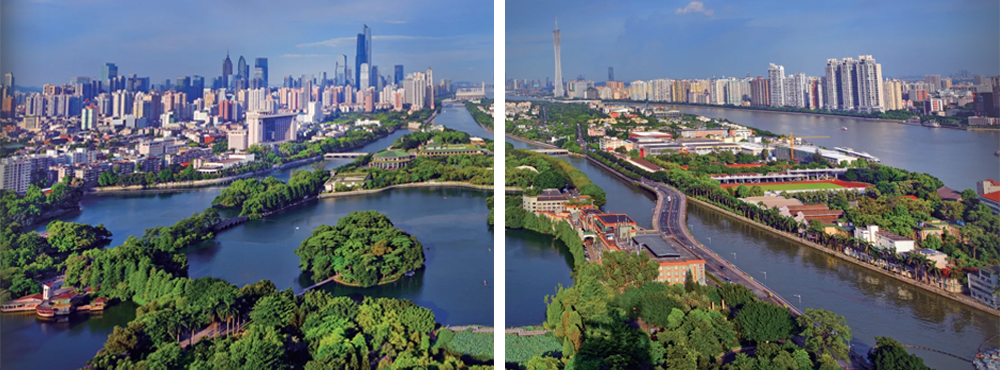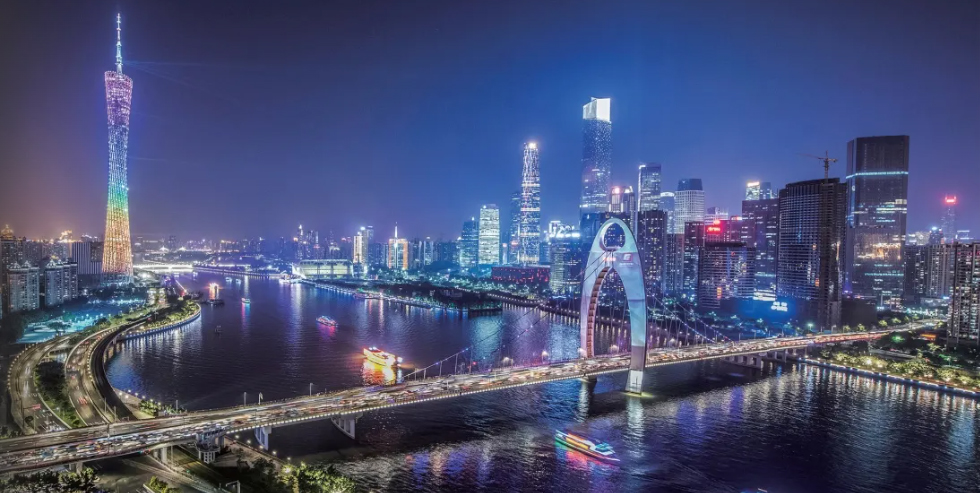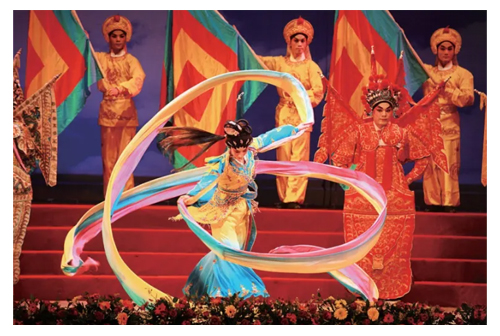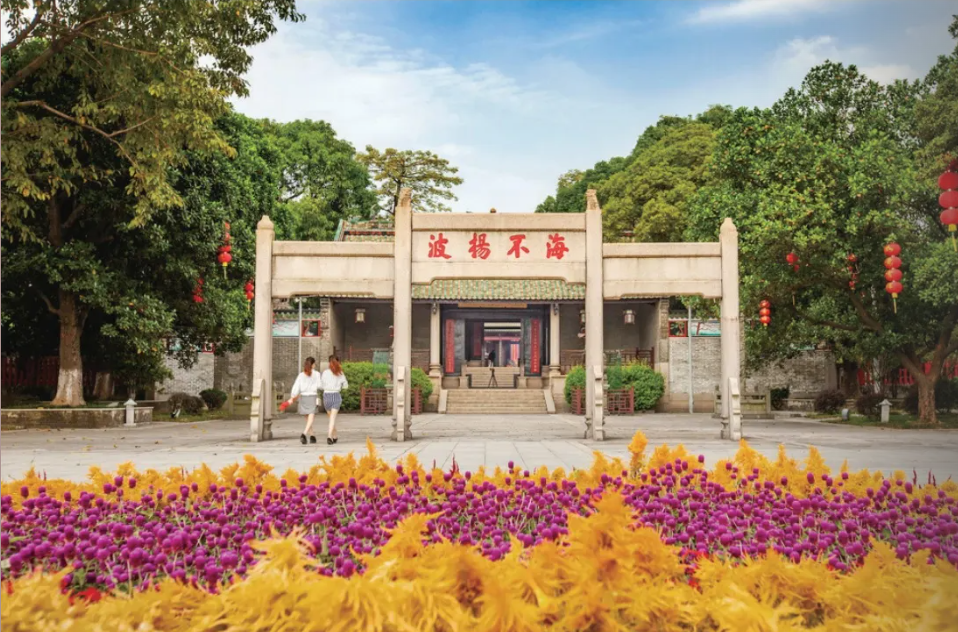
Basic Information
Guangzhou is the capital city of Guangdong Province, serving as its political, economic, science and technology and education center. Located in the south of the Chinese Mainland and southeast of the Province, the city lies at the northern edge of the Pearl River Delta, bordering on the South China Sea, and neighboring Hong Kong and Macau. As a regional central city and transportation and communication hub in South China, it is known as the“ Southern Gateway" to China.
Guangzhou is a preeminent historical and culture city. As documented in ancient literature, the city walls were built in as early as 214 B.C. With ahistorical legacy of more than 2200 years, it boasts many cultural relics that vividly reflect its development at various historical stages. In order to strengthen his rule, Sun Quan divided the original Jiaozhou into two parts- Jiaozhou and Guangzhou, name of Guangzhou was established. When the municipal council was set up in 1921, Guangzhou became the city it is today. Since flowers here blossom all year round, Guangzhou is called "City of Flowers". Guangzhou has other nicknames such as "Yangcheng" (City of Rams) and "Suicheng".
Guangzhou is also the cradle of Chinese modern democratic revolution. It has witnessed many significant revolutionary events in the country's history, such as the Sanyuanli Uprising against the British invaders in 1840 when the British Empire invaded China from its “Southern Gateway”, the peasant uprising led by Hong Xiuquan during the Qing Dynasty, the Hundred Days’ Reform advocated by the reformist thinkers Kang Youwei and LiangQichao, and the 1911 Revolution against the feudal regime and the famous Huanghuagang Uprising led by Sun Yat-sen.
Today, as a pioneer in China's reform and opening up and a window for foreign trade, the city witnesses tremendous economic growth and all-round development, It is one of the most economically active cities in China and ranks among the country's top three major cities in terms of comprehensive economic strength.
The economic growth has propelled the continuous improvements in the city's appearance and living environment, As the intersection of Beijing. Guangzhou Railway, Guangzhou-Shenzhen Railway, Guangzhou-Maoming Railway and Guangzhou-Meizhou-Shantou Railway as well as the civil aviation hub in South China, the city is easily accessible from different parts of the country. The successful completion of major projects, such as Guangzhou Metro consisting of 15 lines, the Ring Expressway, the Yajisha Bridge, Guangzhou International Convention and Exhibition Center, Guangzhou Baiyun International Airport, and Guangzhou Higher Education Mega Center, testifies that Guangzhou, a thousand-year-old city, still thrives as a modern international metropolis in the 21st century.

Administrative Districts and Population
 Guangzhou covers a total area of 7,434.40
km2, accounting for 4.21% of the total land area of Guangdong
Province. It has 11 districts under its administration, namely Yuexiu, Haizhu,
Liwan, Tianhe, Baiyun, Huangpu, Huadu, Panyu, Nansha, Conghua and Zengcheng.
Guangzhou covers a total area of 7,434.40
km2, accounting for 4.21% of the total land area of Guangdong
Province. It has 11 districts under its administration, namely Yuexiu, Haizhu,
Liwan, Tianhe, Baiyun, Huangpu, Huadu, Panyu, Nansha, Conghua and Zengcheng.
At the end of 2022, Guangzhou housed a diverse population of 18,734,100 people.
There are 55 ethnic minorities with a total
population of 827,000 in Guangzhou. Among them, those with a register
certificate (Hukou) is about 118,000, mainly coming from ethnic groups such as
Zhuang, Hui, Manchu, Tujia and Yao. Those without such certificate is about 709,000,
mainly coming from ethnic groups such as Zhuang, Hui, Tujia, Miao, Yao and Dong.
Guangzhou has recorded one of the fastest and largest increase in the population
of ethnic minorities among Chinese cities. There are three ethnic primary
schools including Hui Primary School, Manchu Primary School, and She Primary
School, enrolling 327 ethnic minority students; one ethnic minority village
(She Ethnic Minority Village, Zhengguo Town, Zengcheng District, with 385
villagers form 88 households); 10 schools enrolling 1,366 Xinjiang and Tibetan
students (including 6 schools, namely Guangya HighSchool, Guangzhou No. 6
Middle School, Guangzhou No. 75 Middle School, Yuyan Middle School, Xiehe High
School and Yushan High School offering high school classes for Xinjiang
students, two schools, namely Guangzhou Vocational School of Finance and
Business and Guangzhou Vocational School of Municipal Administration offering
vocational classes for Xinjiang students, and two schools, namely Guangzhou
Vocational School of Medicine and Guangzhou Health Science College offering
vocational classes for Tibetan students); nearly 2,000 halal ramen stores and
restaurants; four ethnic organizations at municipal level, namely Guangzhou
National Unity and Progress Association, Guangzhou Manchu History and Culture
Research Association, Guangzhou Hui History and Culture Research Association,
and Guangzhou Society of Ethnic Minority Sports.

History
Guangzhou is among the first national historic cities recognized by the State Council. In as early as the Neolithic Age six to seven thousand years ago, the ancestors lived and multiplied on this land, creating a splendid prehistoric civilization and opening the first chapter of humanities in the city, Guangzhou is also known as Ram City and Rice Ear City. Legend has it that in ancient times, five immortals arrived in Guangzhou riding five-color rams that carried ears of rice to the people, blessing the city to be free from famine. Today, the Five Ram Statue in Yuexiu Park has become a symbol of Guangzhou.
For more than 2,000 years from the Qin and Han dynasties to the Ming and Qing dynasties, Guangzhou had been a prominent port city for foreign trade in China. During Emperor Wu's reign in the Han Dynasty, China's fleets setoff from the city and sailed to the Southeast Asian and South Asian countries for trade, and during the Eastern Han Dynasty they sailed even farther to the Persian Gulf, In the Tang Dynasty, Guangzhou was known as a world-famous oriental port city, as well as the starting point of the then world's longest sea route, Guangzhou Maritime Route. The Maritime Trade Commissioner appointed by the central government came to Guangzhou to administer the foreign trade. Later in the Song Dynasty, Maritime Trade Superintendency, the country's first agency to manage foreign trade, was established in the city. During the Ming and Qing dynasties, Guangzhou became a special open port, and for a long time it was the only port city for foreign trade in the country.
Guangzhou is a heroic city rooted in a glorious revolutionary tradition. In modern times, the city bore witness to the battle against the British invaders in Sanyuanli, the Huanghuagang Uprising against the feudal regime led by Sun Yat-sen, and Guangzhou Uprising led by the Communist Party of China. It is not only the cradle of bourgeois revolution in China, but also a heroic city where the people were engaged in revolutionary struggle led by the proletarian party leaders.
Guangzhou is home to generations of great achievers, such as Ren Xiao in the Qin Dynasty, Zhao Tuo in the Han Dynasty, Ge Hong in the Jin Dynasty, Huineng in the Tang Dynasty, Zhan Ruoshui in the Ming Dynasty, scholars Qu Dajun and Ruan Yuan in the Qing Dynasty, Lin Zexu who led the antiopium campaign, Hong Xiuquan who led peasant uprisings, Zhang Zhidong are presentative of the Westernization Movement, thinkers and political reformers Kang Youwei and Liang Qichao, and Sun Yat-sen who led the Chinese democratic revolution and overthrew the feudal system of monarchy which had ruled China for several thousands of years. They all made great contribution to the formation and development of this reputed historic city.
Guangzhou features a wealth of cultural relics and historic sites. The outstanding examples include: the Mausoleum of Nanyue King of more than2,000 years of history, Guangxiao Buddhist Temple, Liurong Temple and Huaisheng Mosque of more than 1,000 years of history, Nanhai God Temple built in the Sui Dynasty, Wuxian Taoist Temple, Zhenhai Tower and LotusPagoda in the Ming Dynasty, and Chen Clan Ancestral Hall and Yuyin Garden in the Qing Dynasty, Memorial sites of modern revolution include the site of Peasant Movement Institute where Comrade Mao Zedong once hosted the workshop, Guangzhou Martyrs’ Memorial Garden, Cemetery of the 72 Martyrs in Huanghuagang, the site of Whampoa Military Academy, Sun Yat-sen Memorial Hall and the former residence of Hong Xiuquan. There are also many scenic spots in the city. Back in the Song, Yuan, Ming and Qing dynasties, it was a tradition to select the Eight Views of the city. After the founding of the People's Republic of China in 1949, the city has seen rapid progresses in urban construction and development. On May 18, 2011, the results of the New Eight Views of Guangzhou were announced, namely the Tower in the Zhujiang New Town (Canton Tower), the Flowing River (the Pearl River), the Verdant Mountain (Baiyun Mountain), the Glamor of Yuexiu (Yuexiu Mountain), the Renowned Ancient Academy (Chen Clan Ancestral Hall), the Wonderland in Liwan (Lychee Bay River), the Splendid Science City (Guangzhou Science City), and the Sunset at the Wetland (Nansha Wetland).

IV. Foreign Exchanges
Guangzhou is a renowned international metropolis with a long history. In as early as B.C. years, it has maintained close and fiiendly exchanges with foreign countries. As one of the starting points of the famous Maritime Silk Road, the city has been engaging in foreign trade for more than 2,000 years.
As of December 2021, Guangzhou has established sister city ties with 38cities of 35 countries on six continents, including 12 cities of 10 countries in Europe, 2 cities of 2 countries in North America, and 6 cities of 6 countries in Latin America, 12 cities of 11 countries in Asia, 4 cities of 4 countries in Africa, and 2 cities of 2 countries in Oceania.
As of December 2021, the city has forged friendship city relationships with 62 cities of 44 countries on six continents, including 23 cities of 13countries in Europe, 5 cities of 2 countries in North America, and 7 cities of6 countries in Latin America, 15 cities of 13 countries in Asia, 7 cities of 7countries in Africa, and 3 cities of 2 countries in Oceania. (See the official website of the Foreign Affairs Office of Guangzhou Municipal People's Government for details.)

Government Services
Most foreign-related functional departments in Guangzhou are able to handle enquiry, complaints and formalities in English. All government departments have websites in Chinese and English bilingually to provide information on policies, regulations and guidelines. Online services are available for businesses relating to industry, commerce and taxation. The office hours of government departments are from 9:00 am to 12:00 pm, and 2:00 pm to 6:00 pm, Monday to Friday (except statutory holidays). Those who need service on public holidays may contact relevant government departments in advance to make an appointment. Please visit the portal of Guangzhou municipal government (website: www.gz.gov.cn) to learn more about the latest government policies and everyday information.
Guangzhou Multilingual Public Service hotline 960169 established by the Foreign Affairs Office of Guangzhou Municipal People's Government provides free interpretation service for inquiries concerning public services and policy consultancy in English, Japanese and Korean. This hotline may be connected with other government and public service hotlines such as 12345, 110, 119, 120,96158 (Baiyun Airport), and 96900 (Guangzhou Traffic) to provide real-time interpretation through three-way call. The hotline in English operates 24 hours a day, and that in Japanese and Korean between 9:00 am and 9:00 pm.
Foreign Affairs Office of Guangzhou Municipal People's Government
Address: 311 Yuexiu Beilu, Guangzhou
Website: http://www.gzfao.gov.cn





 京公网安备
京公网安备